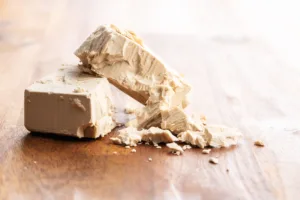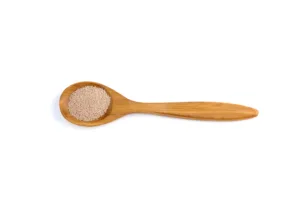Yeast and Science
Some may get worried or turned off by the concept of working with a living organism when cooking. If this is the first time you have worked with yeast. It can be very comfronting at first glance. But it can be fun once you get started and give it the respect it deserves. In this article, we will be taking a deep dive into this organism and how the different types are used in baking today. Some of the world’s most popular food is made with yeast. Some examples include pizza, bread and doughnuts! So much so that many cultures worldwide have adopted their own versions. (Bread from around the globe blog, coming soon).
So read on so we can begin to demystify yeast!
What is Yeast?
Yeast is part of the fungi family. There are over 100 variations of yeast, and as you can imagine, not all are great for food. Some are responsible for infections and food spoilage. But thankfully, some variations are wonderful for beer and food production! So constantly give and take, good and bad, everything has a balance.
Manufacturing
So how is yeast produced today and on a large enough scale?
It all starts with an ideal environment closely monitored around the clock.
Some monitored elements are oxygen, nutrients, temperature, PH and sugars.
All of these elements must be regulated. For example, the velocity of yeast growth can be controlled by the amount of food it has access to. This process continues until the yeast has the ideal properties for baking!
Types
Fresh yeast is processed minimally. The manufacturers do not put this form of yeast through a drying process, resulting in short shelf life. With the varying moisture levels that this form of yeast has, it becomes an unpredictable product to work with. It can result in different results for every batch.

Cream yeast is definitely not a product many home bakers will not use. This is the least processed of all the yeast products listed. This form of yeast is actually a by-product of the yeast production process. Due to its high moisture content of 80%, it is highly perishable. Making this product not highly sought after. Best sourced for bakeries less than 1.6km from the point of manufacturing must remain under refrigeration.
Compressed yeast has a moisture content of 30%. It still has to be refrigerated but is less perishable than the products mentioned above. Compressed yeast boasts more leavening-causing gases than other yeast forms and is sold in blocks.

Active Dry-Yeast was first introduced in the 1920s. The yeast is taken from the manufacturing vat and then undergoes a drying process, which reduces its moisture to 7 – 9%. ADY forms a coating of yeast debris. So when working with ADY, it is best practice to soak it in water 35’c – 43’c for 15 minutes. This will rehydrate the yeast. ADY is like baby bear. It wants its bath to be just right. So if you run the water too cold, it will recover poorly. Producing substances that affect the gluten protein formation. If you run its bath too hot, above 48’c, you will kill the yeast. So remember “Goldilocks And The Three Bears” when working with ADY. That will keep you out of trouble and on the right track for a great result.

Instant Dried Yeast is produced much the same way as ADY, but drying is much quicker. This rapid drying process results in no fallen yeast soldiers; therefore, no coating of yeast debris is formed. This is terrific news for us because it saves time. In addition, IDY does not require the baby bear treatment from above and can be used immediately. I still prefer to give IDY a little bath in warm water with a pinch of sugar and flour. This additional step helps to get things going. A key consideration when working with IDY, though, is the water you use in the recipe should still be 21’c or above. Be careful not to add water that is too hot. But by all means, mix this straight with your flour, and you should not have a problem.
Remember
One key point! Sugar is food for this beautiful organism and will speed up the production of leavening gases. While salt should never be mixed directly with the yeast, this will kill the poor little bugger. A great way to ensure this doesn’t occur is to mix your yeast with the water and the salt with the flour, then combine them. This will keep them separate. Also, the amount of salt in a recipe will affect the proofing time. So higher the salt content, the longer the proof will take. This can also be said by the temperature and humidity in your environment. The higher these factors, the faster the proof. Some bakers will make the dough and then place it in the fridge to slow the yeast down. This will help the dough enhance its flavour. We love to do this overnight.
Conversion
Ok, so you have stumbled across a recipe you want to use. Only to find it uses a different yeast product than you have. Well, do not worry. If this is the case, you can always convert it to the yeast you have.
If a recipe calls for Compressed or Fresh yeast and you want to use ADY then multiply the original amount by 0.5. This will result in the amount of ADY you need. Alternatively, if you’re going to use IDY then multiply by 0.33.
On the other hand, if you want to use compressed or fresh yeast, then multiply ADY by 2. Multiply IDY by 3.
Lastly, if the recipe calls for IDY and you want to use ADY, multiply IDY by 1.33. Alternatively, if the recipe calls for ADY and you wish to use IDY multiply ADY by 0.75
Get Baking
This breakdown of yeast really helps get you in that kitchen and baking bread. The key point is don’t be discouraged. Get in there and give it a shot! You will amaze yourself, your family and your friends with what you are capable of! If you have any more questions you want to be answered, please reach out and let us help you! Most of all, show yeast the respect it deserves, and it will give you a fantastic product that will provide you with some bragging rights. Finally, remember to share what you make on our Facebook community. We would love to be a part of this journey with you.
Until next time….
Bradley Cameron
References
The research for this article came from a range of books.
“On Food And Cooking” Harold McGee
“Professional Bread Baking” Hans Welker
“On Baking” Sarah R Labensky, Read the review